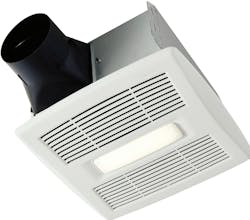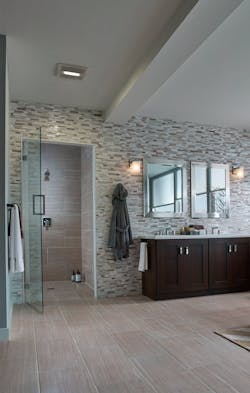The goal of Broan’s InVent series of ventilation fans is to improve ease of installation, ducting, and wiring for both remodels and new construction.
One of the challenges of retrofitting a bath fan is that, typically, the mounting ears jut out from the sides of the fan’s housing, says Broan marketing manager Patrick Nielsen, so you can’t simply remove the old housing, cut the new drywall hole, and install the new housing right there in the room because the mounting ears would be visible. Broan has solved the problem by making its mounting ears bendable. “We put creases in the ears, as well as some strategically placed holes in the sheet metal, so if you’re doing a room-sideretrofit, those mounting ears will fold against the housing and allow it to slide right up into the drywall hole,” Nielsen says. “What this series is all about is turning a retrofitting project from something you’d normally have to do from the attic to something you can do from the bathroom itself.”
To that end, Broan has also designed its InVent fan so ductwork and wiring work can be completed within the system’s housing rather than outside it, as is the case with traditional fans. “You just reach through the hole in the housing, grab the existing ductwork, pull it into the housing, tape it, or attach it however you want to the duct connector, and then the duct connector mounts from the inside,” Nielsen says, adding that it’s the same case for the wiring. “We’ve made a lot of allowances to ensure the total installation can be done within the same room.”
Beyond the retrofitting solutions, the InVent series fan comes equipped with additional bells and whistles, such as an LED lighting system, humidity sensor, and its TrueSeal damper flap, which, when given the 50 pascals blower-door test, proved more airtight than its competitors, according to Nielsen.

